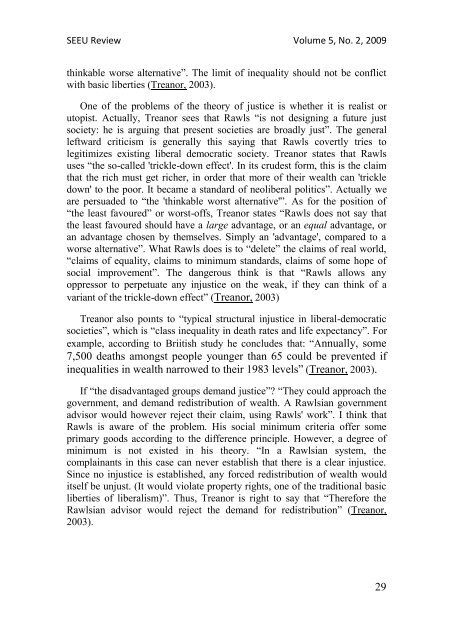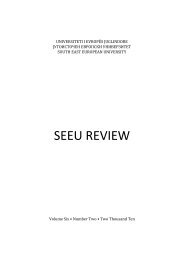SEEU Review vol. 5 Nr. 2 (pdf) - South East European University
SEEU Review vol. 5 Nr. 2 (pdf) - South East European University
SEEU Review vol. 5 Nr. 2 (pdf) - South East European University
Create successful ePaper yourself
Turn your PDF publications into a flip-book with our unique Google optimized e-Paper software.
<strong>SEEU</strong> <strong>Review</strong> Volume 5, No. 2, 2009<br />
thinkable worse alternative”. The limit of inequality should not be conflict<br />
with basic liberties (Treanor, 2003).<br />
One of the problems of the theory of justice is whether it is realist or<br />
utopist. Actually, Treanor sees that Rawls “is not designing a future just<br />
society: he is arguing that present societies are broadly just”. The general<br />
leftward criticism is generally this saying that Rawls covertly tries to<br />
legitimizes existing liberal democratic society. Treanor states that Rawls<br />
uses “the so-called 'trickle-down effect'. In its crudest form, this is the claim<br />
that the rich must get richer, in order that more of their wealth can 'trickle<br />
down' to the poor. It became a standard of neoliberal politics”. Actually we<br />
are persuaded to “the 'thinkable worst alternative'”. As for the position of<br />
“the least favoured” or worst-offs, Treanor states “Rawls does not say that<br />
the least favoured should have a large advantage, or an equal advantage, or<br />
an advantage chosen by themselves. Simply an 'advantage', compared to a<br />
worse alternative”. What Rawls does is to “delete” the claims of real world,<br />
“claims of equality, claims to minimum standards, claims of some hope of<br />
social improvement”. The dangerous think is that “Rawls allows any<br />
oppressor to perpetuate any injustice on the weak, if they can think of a<br />
variant of the trickle-down effect” (Treanor, 2003)<br />
Treanor also poınts to “typical structural injustice in liberal-democratic<br />
societies”, which is “class inequality in death rates and life expectancy”. For<br />
example, according to Briitish study he concludes that: “Annually, some<br />
7,500 deaths amongst people younger than 65 could be prevented if<br />
inequalities in wealth narrowed to their 1983 levels” (Treanor, 2003).<br />
If “the disadvantaged groups demand justice”? “They could approach the<br />
government, and demand redistribution of wealth. A Rawlsian government<br />
advisor would however reject their claim, using Rawls' work”. I think that<br />
Rawls is aware of the problem. His social minimum criteria offer some<br />
primary goods according to the difference principle. However, a degree of<br />
minimum is not existed in his theory. “In a Rawlsian system, the<br />
complainants in this case can never establish that there is a clear injustice.<br />
Since no injustice is established, any forced redistribution of wealth would<br />
itself be unjust. (It would violate property rights, one of the traditional basic<br />
liberties of liberalism)”. Thus, Treanor is right to say that “Therefore the<br />
Rawlsian advisor would reject the demand for redistribution” (Treanor,<br />
2003).<br />
29

















